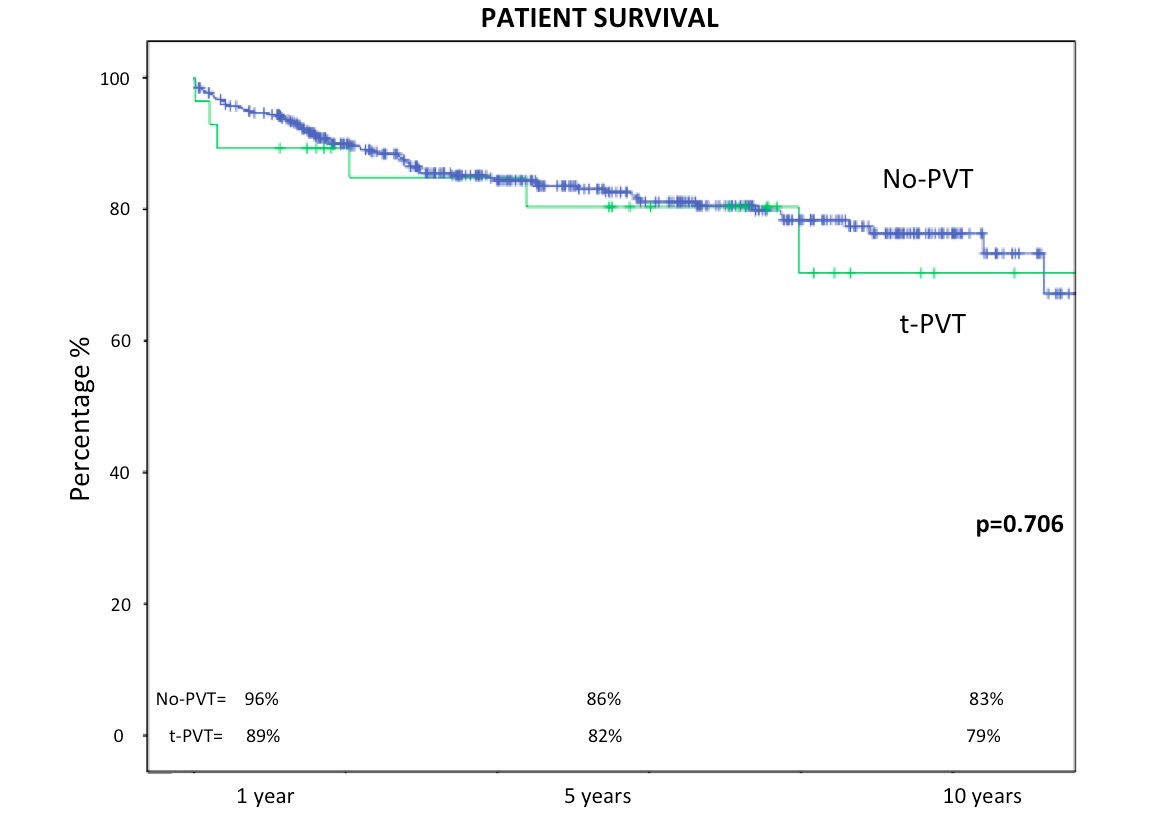De-Novo Portal Vein Thrombosis After Adult-to-Adult Living Donor Liver Transplantation (LDLT) Does Not Impact on Long-Term Outcome.
1Department of Surgery, Multi-Organ Transplant Program, Toronto General Hospital, University Health Network, Toronto, ON, Canada
2Department of Medicine, Multi-Organ Transplant Program, Toronto General Hospital University Health Network, Toronto, ON, Canada
3Department of Anesthesiology, Toronto General Hospital, University Health Network, Toronto, ON, Canada
Meeting: 2017 American Transplant Congress
Abstract number: B224
Keywords: Graft survival, Liver transplantation, Post-operative complications, Risk factors
Session Information
Session Name: Poster Session B: Living Donors and Partial Grafts
Session Type: Poster Session
Date: Sunday, April 30, 2017
Session Time: 6:00pm-7:00pm
 Presentation Time: 6:00pm-7:00pm
Presentation Time: 6:00pm-7:00pm
Location: Hall D1
Portal vein thrombosis(PVT) after deceased donation has been widely described as a liver transplant complication that can lead to graft failure, high morbidity and mortality. Little data is available regarding to risk factors, classification and treatment of PVT after LDLT.
Methods
Retrospective analysis of 421 adult-to-adult LDLTs performed between January-2004 and November-2014. Perioperative characteristics and outcomes of patients with a new PVT after LDLT(n=28) were compared with those without PVT (n=393).
Results:
Twenty-eight patients had a new PVT(t-PVT). Ten cases were classified as early-PVT(e-PVT) occurring within 1 month after LDLT, and 18 cases as late-PVT(l-PVT) appearing later than 1month. Multivariate analysis from perioperative variables showed that splenectomy(t-PVT: p=0.001; e-PVT: p=0.012; l-PVT: p=0.035) and donor age(l-PVT: p=0.010) were significant risk factors for PVT. Salvage rate for treatment in e-PVT and l-PVT was 100% and 50%, respectively, without early event of re-thrombosis. Mortality within 30days was similar (No-PVT: 2% vs e-PVT: 10%, p=0.155). No significant difference in the 1-(92% vs 89%), 5-(82% vs 79%) and 10-(79% vs 68%) years graft survival between the No-PVT and t-PVT groups (p= 0.246). No retransplantion was neccesary as consequence of PVT. The 1-(96% vs 89%), 5-(86% vs 82%) and 10-(83% vs 79%) years patient survival was similar for the patients without PVT and the t-PVT group (p=0.706) Conclusion
Conclusion
Early diagnosis and management of PVT after LDLT can lead to acceptable early and long-term results without affecting patient and graft survival.
CITATION INFORMATION: Linares I, Goldaracena N, Rosales R, De La Maza L, Echeverri J, Kaths M, Kollman D, Selzner N, McCluskey S, Sapisochin G, Lilly L, Greig P, Bhat M, Ghanekar A, Cattral M, McGilvray I, Grant D, Selzner M. De-Novo Portal Vein Thrombosis After Adult-to-Adult Living Donor Liver Transplantation (LDLT) Does Not Impact on Long-Term Outcome. Am J Transplant. 2017;17 (suppl 3).
To cite this abstract in AMA style:
Linares I, Goldaracena N, Rosales R, Maza LDeLa, Echeverri J, Kaths M, Kollman D, Selzner N, McCluskey S, Sapisochin G, Lilly L, Greig P, Bhat M, Ghanekar A, Cattral M, McGilvray I, Grant D, Selzner M. De-Novo Portal Vein Thrombosis After Adult-to-Adult Living Donor Liver Transplantation (LDLT) Does Not Impact on Long-Term Outcome. [abstract]. Am J Transplant. 2017; 17 (suppl 3). https://atcmeetingabstracts.com/abstract/de-novo-portal-vein-thrombosis-after-adult-to-adult-living-donor-liver-transplantation-ldlt-does-not-impact-on-long-term-outcome/. Accessed December 24, 2025.« Back to 2017 American Transplant Congress
